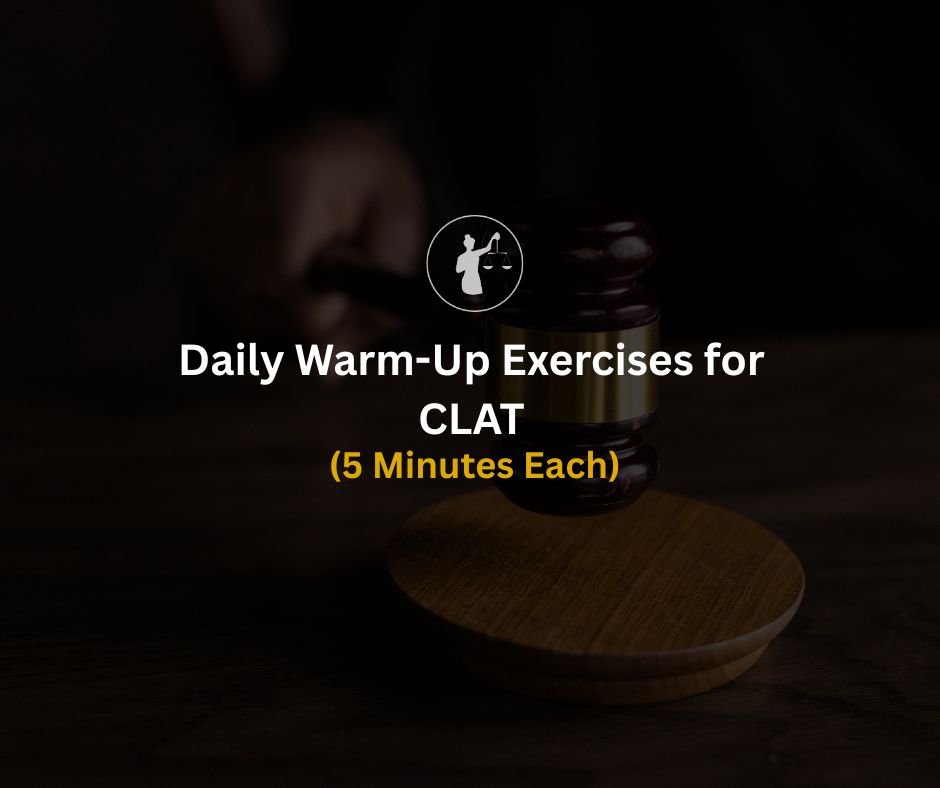
Summary
Every CLAT topper follows a few common habits: they start early, master the basics, analyze every mock, and improve step by step. From Saksham Gautam’s disciplined planning to Akshat Shraff’s 70+ mocks and peer-led GK prep, their journeys prove that consistency, strategy, and smart practice matter more than long study hours. This guide breaks down their approaches so you can use the same methods for CLAT 2026.
Best CLAT Online Coaching 2026–2027 by NLTI
Saksham began in Class 11, ran a dynamic timetable that flexed with school load, and scaled to 2–4 mocks per week near the end, each followed by deep analysis. The hard part was cutting social media; he imposed a clean break, then rebuilt self-discipline. He credits targeted mentorship and task-based planning.
Replicable moves
Plan by tasks, not hours.
Add a mock only if you have time to analyze it fully.
Remove attention drains for 3–4 weeks to reset focus.
Ananya front-loaded fundamentals by starting in Class 11. He treated quantitative techniques as a weakness to be trained daily, not dodged. Mocks were used to isolate gaps and iterate.
Replicable moves
If QT is weak, schedule short daily sets plus weekly caselet recaps.
Use every mock to tag one fix per section.
Read More: CLAT Prep in Tamil Nadu: Beating English & GK Gaps
Vidit built his plan on previous years’ questions to understand pattern logic, then kept a stable daily loop: newspaper → math practice → sectional or mock → analysis → GK and vocab. Scores: 100/116 overall with strong Legal and GK, after starting in Class 12 and scaling hours near the end.
Replicable moves
Start with PYQs to learn passage styles and distractor patterns.
Fix weak sections by revisiting theory, then running short sectionals before full mocks.
Akshat used a Notion-based GK tracker with friends, alternate-day GK huddles in the last month, and more than 70 mocks with a three-column error sheet: “wrong,” “why,” and “next time.” Weekly color-coded accuracy reviews kept him honest. He worked with a senior-rank mentor for time budgets and accountability.
Replicable moves
Build one living GK doc with peers.
After each mock, log the cause of errors, not just the count.
Track section accuracy weekly; intervene when a metric stalls.
Read More: How NCR Students Consistently Dominate CLAT Ranks
After Supreme Court-driven revisions, ranks shifted for several candidates; Saksham retained AIR 1, while others moved, including Siddhi Ladda, who improved to AIR 15. Small mark corrections changed outcomes, underscoring accuracy and calm. This is an inference from official topper lists and legal commentary.
Replicable moves
Prioritize clean attempts over volume.
Train for ambiguity; treat answer-key disputes as uncontrollables.
Early start, 40+ mocks under timed conditions, heavy LR focus, and routine GK revision. The structure transfers cleanly to CLAT: schedule mock-analysis loops and protect high-weight reading sections.
From these interviews, the overlaps are plain:
1. Mocks with intent
Two to four per week near the end, each tied to a written analysis ritual. Add mocks only if you can review them.
2. PYQ-first orientation
Map passage types, traps, and timing from previous papers before expanding material.
3. GK as a system, not a PDF pile
Daily newspaper + a consolidated tracker; weekly peer recaps to cement recall.
4. Time budgets per section
Fix a default order and minute-caps; rehearse at exam time every day in the last month.
5. Minimal resources, maximal repetition
Stick to a short list and cycle it; depth beats breadth.
6. Distraction management
Short, total breaks from social media to rebuild attention.
7. Mentorship and peer accountability
Scheduled check-ins, error reviews, and honest feedback loops.
Read More: Landmark Supreme Court Judgments for CLAT (2020–2025)
Weeks 1–2: Baseline and build
Take 3 full mocks across two weeks; log accuracy, attempt count, and overtime flags per section.
Run 10–12 PYQ passages each in Legal and LR; tag common stem patterns.
Start a single GK tracker; add 10 daily bullets + weekly recap.
Weeks 3–4: Tighten systems
Two mocks/week, each with a 30-minute analysis script.
Daily QT micro-sets if weak; measure accuracy before speed.
Fix a section order and minute-caps; rehearse at the exam hour.
Weeks 5–6: Simulate and sharpen
Three mocks/week under full constraints. No new sources.
Convert every repeat error into a pre-mock checklist.
GK: peer quiz twice a week; prune notes to “must-know.”
Read More: CLAT 2026 Difficulty Prediction: Key Insights from CLAT 2025 Paper
English RC
Title and tone drills, 3 sets/day on alternating difficulty; clip rereads with a two-pass rule.
Logical Reasoning
Argument mapping on scrap paper. Track misreads and assumption errors. Use LSAT-style passages for stretch.
Legal Reasoning
Principal banks for tort/contract/crime. Rework wrong options every Sunday.
Quantitative Techniques
Caselet-only timers. Aim for ≥85% accuracy before raising attempts.
GK / Current Affairs
One daily newspaper + one living doc; no PDF hoarding. Weekly oral recap with a study buddy.
Saksham: task-based planning, strict post-mock analysis, temporary social detox.
Ananya: Early foundation and daily QT; use mocks as diagnostics, not scoreboards.
Vidit: PYQ-led pattern study and a fixed day loop that balances all sections.
Akshat: peer GK systems, 70+ well-analyzed mocks, weekly accuracy dashboards, mentor accountability.
Saher (AILET): high LR weight focus, 40+ timed mocks, and calm execution.
CLAT 2026 winners will do three simple things: run a lean resource stack, analyze every mock in writing, and rehearse a time-budgeted section order at the exam hour. The profiles above point to the same mechanics, independent of coaching brand or city. Use their systems, not their slogans.
Top ranks aren’t about luck; they’re about having the right guidance, and NLTI gives you exactly that.
Personalized mentorship from NLSIU students and alumni: Learn proven strategies directly from those who’ve cracked CLAT and know what it takes.
Smart mock ecosystem: Attempt realistic tests with expert-led analysis to turn mistakes into strengths.
Peer learning and study groups: Collaborate with aspirants nationwide to solve doubts and stay consistent.
Curated GK systems: Access high-yield current affairs resources designed to save time and boost scores.
Mindset and strategy training: Build exam temperament, manage pressure, and learn how toppers think.
With NLSIU mentors guiding you at every step, NLTI ensures you don’t just prepare; you prepare like a future NLU student, with focus, confidence, and the right strategy for CLAT 2026.
1. How much time do CLAT toppers usually study daily?
Most toppers dedicate 4–6 focused hours a day, but what matters more is consistency and quality. They break time into focused slots for reading, mocks, and analysis, a crucial part of any CLAT topper preparation strategy.
2. Do CLAT toppers rely on coaching or self-study?
Many toppers use a mix of both. Coaching platforms like NLTI provide structure, mentorship, and mock analysis, while self-study builds discipline. The best results come from balancing the two.
3. How do toppers approach GK for CLAT 2026?
Toppers follow a daily GK routine, newspaper reading, monthly compilations, and regular quizzes. Most also revise through curated GK trackers, a key element of CLAT topper preparation tips.
4. What do CLAT toppers do differently in the last 30 days?
They shift focus from new topics to mock revision, accuracy tracking, and time management. Most revise error logs and attempt 8–10 full-length tests to simulate real CLAT exam conditions.
5. How important is mentorship for CLAT toppers?
Mentorship plays a huge role. Guidance from NLU and NLSIU mentors helps toppers refine their strategies, avoid common mistakes, and stay motivated, an advantage many cite as crucial to their success.
6. How do toppers deal with low mock scores?
They treat every mock as a learning tool, analysing errors and identifying weak areas. Instead of chasing high scores, they focus on consistent improvement, a mindset key to CLAT topper success.
7. What role does peer learning play in topper preparation?
Study groups, peer discussions, and mock analysis sessions help toppers stay accountable, clarify doubts, and learn faster. It’s one of the most underrated CLAT topper strategies.
8. How do toppers balance school boards and CLAT preparation?
They create smart timetables that prioritize CLAT sections during low academic load periods. Many integrate reading comprehension and GK prep into their school schedule for efficiency.
9. What books or resources do CLAT toppers recommend?
Toppers often stick to a few trusted sources, quality reading materials, past papers, and curated GK compilations, instead of chasing too many books. Focused resources are key for CLAT topper-level prep.
10. How can I follow a topper’s schedule for CLAT 2026?
Start by analyzing your strengths and weaknesses, then model your plan around topper habits: daily reading, regular mocks, detailed analysis, and weekly revision. Platforms like NLTI provide structured schedules followed by past toppers.





